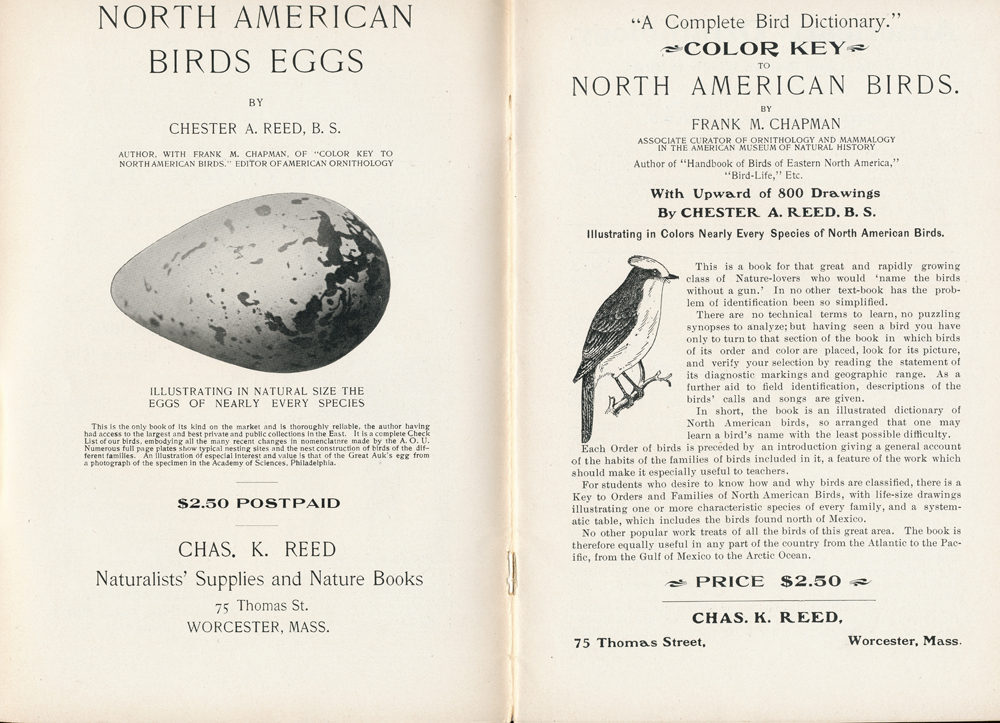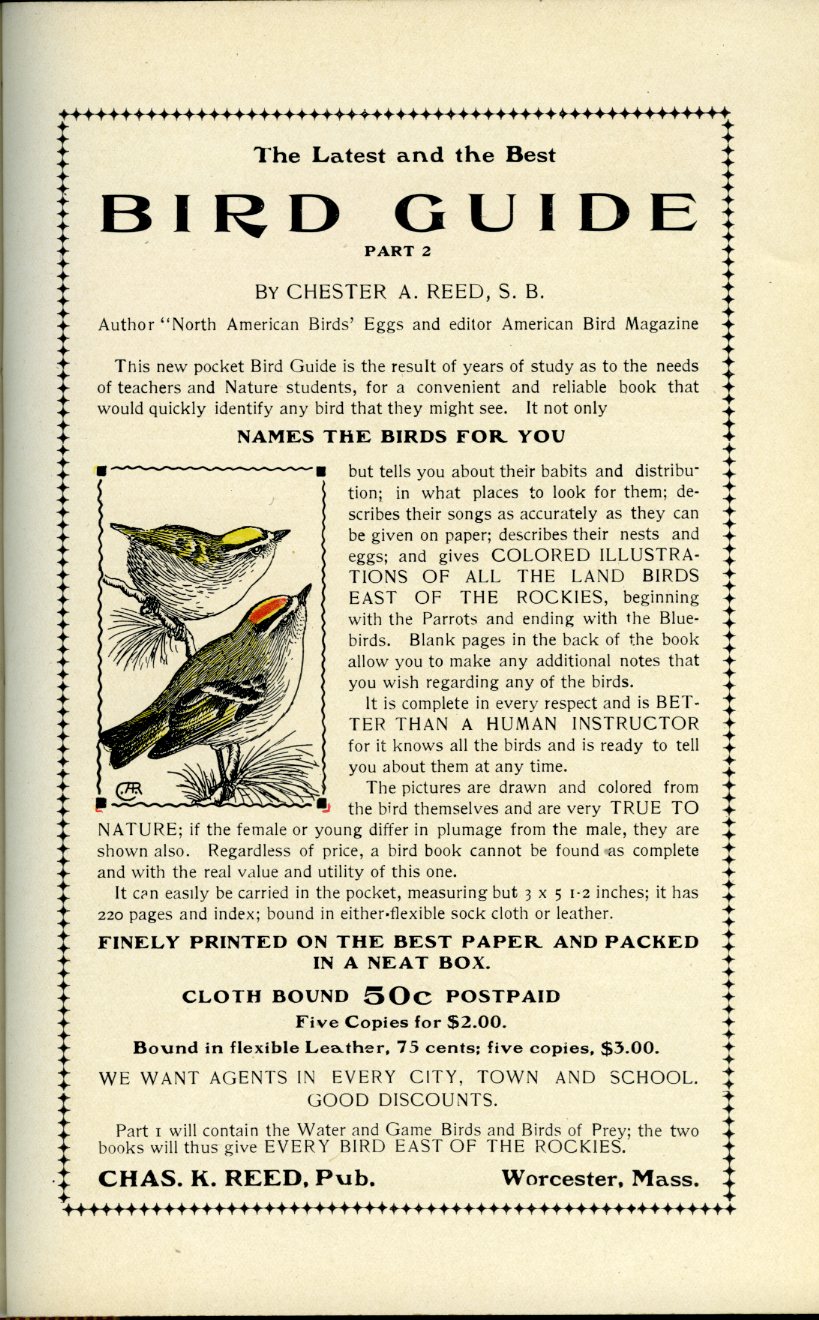Question: 1


Why has Chester A. Reed waited until November 1905 to publish his first book on bird identification “Bird Guide Part 2, Land Birds East of the Rockies”, while he had planned the project in 1902?
Background
When Chester A. Reed published his “Identification Color Chart – No 1” for the first time, his objective was to provide a user-friendly tool to identify birds using a chart describing similar birds’ color characteristics.
When Charles K. Reed made a proposal to Mr. Frank M. Chapman for the publication of his book “Color Key to North American Birds” on February 12, 1902, Charles mentioned, at the end of his letter, that the publication of the book would not conflict with the book that Chester was preparing, “Birds of Eastern North America.” (A)

*Archival Material from the Department of Ornithology American Museum of Natural History, New York. Correspondence between M. F. Chapman and Charles K. Reed, February 12, 1902.
Then, why wait almost 4 years before publishing “Bird Guide Part 2, Land Birds East of the Rockies”, the first bird guide in color for the field identification of birds, published in November 1905? The project was latent since 1902.
To understand the long waiting period, we have to take a look at the business relationship between Charles K. Reed and his son, Chester A. Reed.
When Chester started working at the taxidermy family business in 1896, he was a simple employee. It seems that he had not shown any interest in taking over his father’s business (1). Chester was an educationalist, not so much a businessman. He was paid by his father as an employee of the store. After 1908, he received royalties for the sale of his books. That explains, without a doubt, why Chester’s father owned all of the copyrights to Chester’s books.(B)
Charles K. Reed made all final decisions concerning Chester’s work plan, including the publication of a book. Chester’s work belonged to his father.
Charles K. Reed had the soul of an entrepreneur. In 1875, at 22 years old, he opened his first pet store in Worcester. He had a very good business sense. He built himself an enviable reputation in his field.
Charles had a flair to detect business opportunities. In 1901, Charles decided to edit the magazine “American Ornithology” because he had perceived Chester’s writing skills, and he could use them to profit his enterprise. The publication of the magazine also allowed Charles to advertise the products that he sold in store.(C)
The magazine also gave him opportunities that he used towards his family enterprise, as well as his son’s career. (D)
The Reed family was very religious. Charles was the “head of the household’, but also “head of the enterprise”.
A few days after publishing Chester’s chart in color “Identification Color Chart – No 1”, Mr. Frank M. Chapman came to Charles’ office in Worcester to ask him to publish his book “Color Key to North American Birds.” Charles did not hesitate. On February 12, Mr. Chapman received a proposal from Charles for the publication of the book. (2)
Chester had just developed a bird classification concept using some color characteristics of the bird, which had nothing to do with scientific classification. Mr. Chapman wanted to use that concept. If Chester had published a book using his original idea, he might not have gotten as much visibility, because he would not have benefited from Mr. Chapman’s reputation.
By publishing a book with Mr. Chapman, Chester received greater visibility amongst the amateur and professional ornithologist community in the United States. It highly contributed to establish Chester’s reputation. His father has perceived that opportunity.
To maximize his benefits from the visibility offered by Mr. Chapman, one of the most influential ornithologists of the time, Charles planned to produce a book that would naturally complement Mr. Chapman’s book.
In a letter addressed to Mr. Chapman in December 1903 (2), Chester tells him about his project to publish the book “North American Birds Eggs,” with a format similar to the book that they had published together. The book would be published in April 1904. He asked him for permission to photograph some eggs owned by the American Museum of Natural History. (E)
When the book was published, it was natural to suggest Mr. Chapman’s and Chester’s books to the community of amateur ornithologists.

*«American Ornithology For the Home and School» May 1904.
Charles perceived a business opportunity when Mr. Chapman asked him to publish his book “Color Key to North American Birds.” After the publication of Mr. Chapman’s book, he would have been able to resume the writing project that he held since 1902. However, he chose to publish the book “North American Birds Eggs,” which became a natural complement to Mr. Chapman’s book.
His business strategy wasn’t limited to the publication of a book similar to Mr. Chapman’s. He also made sure that his book “North American Birds Eggs” would be printed and distributed by Mr. Chapman’s editor; Doubleday, Page & Company.
That way, he made sure to get United States wide media coverage from the editor. The editor had also been Charles’ business partner since 1901, and probably long before. (F)
Starting then, Charles managed Chester’s name as a trademark. He made sure to highlight Chester’s relationship and cooperation with Mr. Chapman’s book.

It was probably for that reason that Charles K. Reed owned the copyrights to all of Chester’s books, except for one. The book “North American Birds Eggs” was the only book with Chester A. Reed’s copyright. It was probably caused by the confusion at the registration of the copyright. Charles was still new at that type of transaction, and he never again repeated the same mistake.
After publishing his book “North American Birds Eggs,” Chester undertook the writing and illustrating of his first Bird Guide, which took a bit over a year of work.
“Bird Guide Part 2, Land Birds East of the Rockies” was published for the first time in November 1905. (G) (G)
Charles was not an impulsive person. He was thoughtful and calculating. Even though the book was ready for publication in August 1905, the date when the book’s copyright was registered (3), he preferred to wait until November 1905 to take advantage of the holiday sales frenzy.

When he presented his books, he made sure to specify that Chester was the author of “North American Birds Eggs” and “Color Key to North American Birds.” He highlighted the new reputation for all books published by Chester.
It served him well. A few months after publishing the second Bird Guide “Bird Guide Part 1, Water Birds, Game Birds and Birds of Prey” in May 1906 (H), Charles made an important decision. He would publish the magazine “American Ornithology” for the last time in August 1906. At that moment, Charles made the decision to focus on the publication of books dedicated to nature study. His store showed the change starting in 1908.
In 1902, Charles would probably have been able to edit a very interesting Bird Guide. However, a good businessman, Charles rather chose to take advantage of the opportunity offered by Mr. Chapman and take profit from the business relation to develop Chester A. Reed’s reputation.
When Charles edited “Bird Guide Part 1, Water Birds, Game Birds and Birds of Prey” in May 1906, Chester’s career took a new direction. Charles had a new opportunity; he became editor.
(A) For more information, consult the section “Color Key to North American Birds.”
(B) For more information, consult the section “Chester A. Reed.”
(C) For more information, consult the section “Charles K. Reed.”
(D) For more information, consult the section “American Ornithology for the Home and School.”
(E) For more information, consult the section “North American Birds Eggs.”
(F) For more information, consult the section “Doubleday, Page & Company.”
(G) For more information, consult the section “Bird Guide Part 2, Land Birds East of the Rockies.”»
(H) For more information, consult the section “Bird Guide Part 1, Water Birds, Game Birds and Birds of Prey.”
(1) An undated letter from Doubleday, Page & Company, probably dating back to 1922, after Charles’ death, mentions the little interest that Chester A. Reed had towards his father’s business. The letter authorized Carrie B. Reed to recover the book’s copyright certificate in agreement with Eva M. Reed, Chester A. Reed’s wife. At that time, after Charles’ death, Carrie proceeded to transfer the copyright certificates to her name. A letter from a lawyer at the cabinet “Southgate & Southgate,” dated May 25, 1922 and signed by Albert E. Fay confirms the transfer of propriety.
(2) Archival Material from thr Department of Ornithology American Museum of Natural History, New York. Correspondence between F. M. Chapman and Chester A. Reed, February 1903
(3) « Copyright No 124914, August 26, 1905» Reed family archives